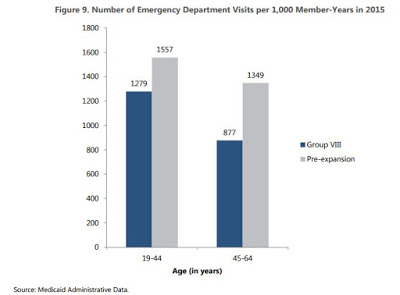Study of Ohio’s Medicaid expansion: Enrollees have better health, more financial security, and say it’s easier to keep or find work

Kentucky Health News
Ohio’s Medicaid expansion enrollees say having health coverage made it easier for them to keep or find work, and most said it gave them better health and financial security.
Their experience is part of a report Ohio’s legislature ordered to evaluate the impact of Gov. John Kasich’s 2014 decision under federal health reform to cover those who earn up to 138 percent of the federal poverty level. Previously, only Ohioans who fell under 90 percent of the poverty line qualified for Medicaid, unless they were disabled or pregnant.
Kentucky, under then-Gov. Steve Beshear, also expanded Medicaid, from a previous threshold of 69 percent of poverty. That added 440,000 people to the program; Ohio added 702,000.
That was the main factor in reducing from 21 percent to 8 percent the share of Kentuckians without health insurance. Among low-income, working-age people, the rate dropped from 38 percent to 13 percent. The Ohio report noted that the state’s uninsured rate dropped to its lowest rate ever, 14.1 percent.
Ohio’s expansion enrollees “overwhelmingly reported that access to medical care had become easier since enrolling in Medicaid,” with 43 percent saying they had fewer unmet health-care needs, the report said.
 |
| Group VIII is the Medicaid expansion population. Graphic is from the Ohio report. |
The report also found that Medicaid expansion enrollees used hospital emergency rooms less often because they were “better integrated into the health care system.” According to the report, 34 percent said they used the emergency department less often, and Medicaid claims data proved it.
Nearly half of expansion enrollees reported that their health had improved; only 3.5 percent that said their health had worsened. Just over a fourth said they had been diagnosed with at least one chronic health condition after obtaining coverage. They also showed fewer instances of high blood pressure and high cholesterol.
“Because they were able to obtain treatment for previously untreated conditions, several of the enrollees stated that they did not think they would be alive today if Medicaid expansion had not occurred,” the report said.
Enrollment in Medicaid also made it easier for its participants to work and to seek work, with 75 percent of those who were unemployed but looking for work reporting that Medicaid made it easier to seek employment. And 52 percent of those who were currently employed said having Medicaid made it easier to keep working.
They also reported that having Medicaid made it easier to meet other basic needs, like food (59 percent) or paying the rent (48 percent) or to pay off other debts (44 percent). Also, the share of expansion enrollees with medical debt fell by nearly half since they enrolled in Medicaid, from 56 percent to 31 percent.
In conclusion, the report said,”These results suggest that Medicaid expansion has and will continue to improve the health of low-income Ohioans enrolled.”
The assessment was independently developed and carried out by a partnership of the Ohio Colleges of Medicine Government Resource Center, The Ohio State University College of Public Health, Ohio University, and RTI International. The data in the report came from a 7,508-person telephone survey, biometric screenings, medical-records reviews, analysis of Medicaid records, and interviews with Medicaid enrollees and stakeholders.